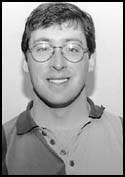 Becoming a family practice physician takes seven years after completing an undergraduate degree. The first four years are in medical school, where the training is fairly general, but for your residency you have to choose the type of medicine you want to pursue.
Becoming a family practice physician takes seven years after completing an undergraduate degree. The first four years are in medical school, where the training is fairly general, but for your residency you have to choose the type of medicine you want to pursue.When he started medical school at the University of Minnesota-Duluth, Bob Berg wanted to know what to expect when he got on the job. He plans to practice medicine in a rural area, and wanted to know many hours would he have to work, how much free time would he have with his family, and whether he would like his job.
"You've got to know if you're going to like it," he explained last week in a corridor at the Paynesville Area Health Care System, where he is spending 10 months studying as a third-year medical student through the Rural Physician Associate Program. "It's not a choice to be taken lightly."
For Berg, working more than 60 hours a week is not an option. With his wife, Carrie, giving birth to their third child last week, he wants to have time to spend with his family. Working more than that, no matter how much he enjoys the job, wouldn't be worth the sacrifice to his family.
When he asked questions about job satisfaction and working hours of family practice physicians while at UMD, he couldn't find any answers, so along with a professor at the medical school, he designed a study to find out.
"I wanted to ask them all and find out what's the range (of hours) and what's the average," said Berg.
They sent out 300 surveys to family practice physicians throughout the state who lived in cities of less than 25,000 and had been in practice for at least five years. There are only 317 family practice physicians in the state who meet those criteria.
The surveys were mailed in the summer of 1998, with help from a small research grant to cover postage costs. Response to mail surveys can be underwhelming.
Berg expected responses from just 40 percent of the physicians. Berg got 60 percent from the initial mailing. A subsequent mailing boosted the res-ponses to 75 percent. "I think it's a pretty representative sam-ple," he said.
Had he got merely 40 percent, he would have wondered if his number were repre-sentative. Or maybe just the doctors with free time had bother-ed to respond.
"As soon as the first surveys started rolling in, I could tell they were satisfied and they were work-ing fewer hours than I expected," said Berg.
Male physicians averaged 52 hours of work each week, and female physicians averaged 39. Males also had a slight edge in on-call hours, 12 to nine, leaving them with an average of 64 hours per week. Women averaged a total of 48 hours.
The gender discrepancy, according to Berg's co-author, UMD professor Dr. Barbara Elliott, is due to females of child-bearing age who negotiate flexible contracts.
"Satisfaction is uniformly high," said Berg. "All of the doctors recorded really high job satisfaction, which made me feel good."
In September 1999, Berg presented the paper at the American Academy of Family Physicians' Scientific Assembly in Orlando, Fla. He took fourth place in the competition for medical students and residents.
The same day he took fourth nation-ally with the paper, he learned that it had been rejected for publication by a national journal, but only because of its focus on the state of Minnesota. They suggested he try a statewide publi-cation.
The paper was published in last month's editition of Minnesota Monthly. Stories about its publication appeared in the Duluth News-Tribune and the St. Paul Pioneer Press.
"This isn't the type of research that will cure cancer, but I think it's a contri-bution," Berg said.
Since October, Berg has learned first-hand about being a family practice physician. As a RPAP student, he is spending the year working with doctors at PAHCS. He spends most days with Dr. Randy Zimmerman, either at the Paynesville Area Medical Clinic or at the Richmond Area Medical Clinic.
"The number of hours I'm working is about what I expected from the study," Berg said. "It's really fun work. I can see why job satisfaction is so high."
Berg still has another year of medical school in the Twin Cities before his residency begins. He likes internal medicine, radiology, and surgery, but feels family practice is his favorite so far.